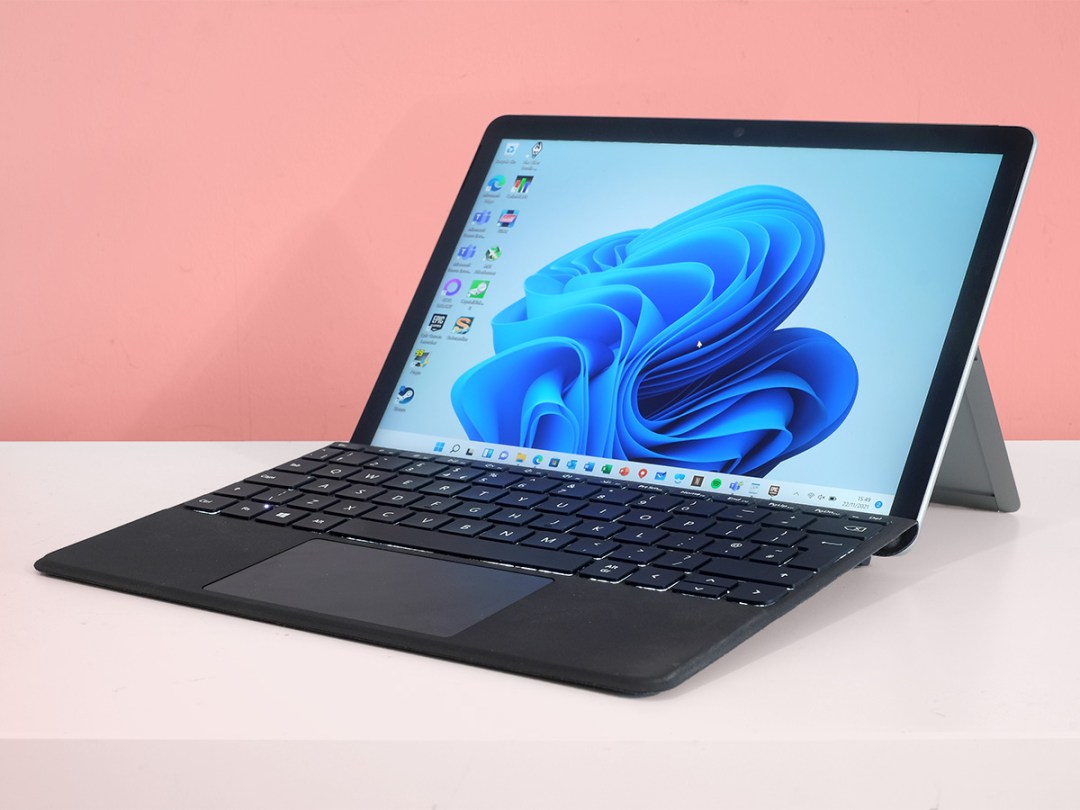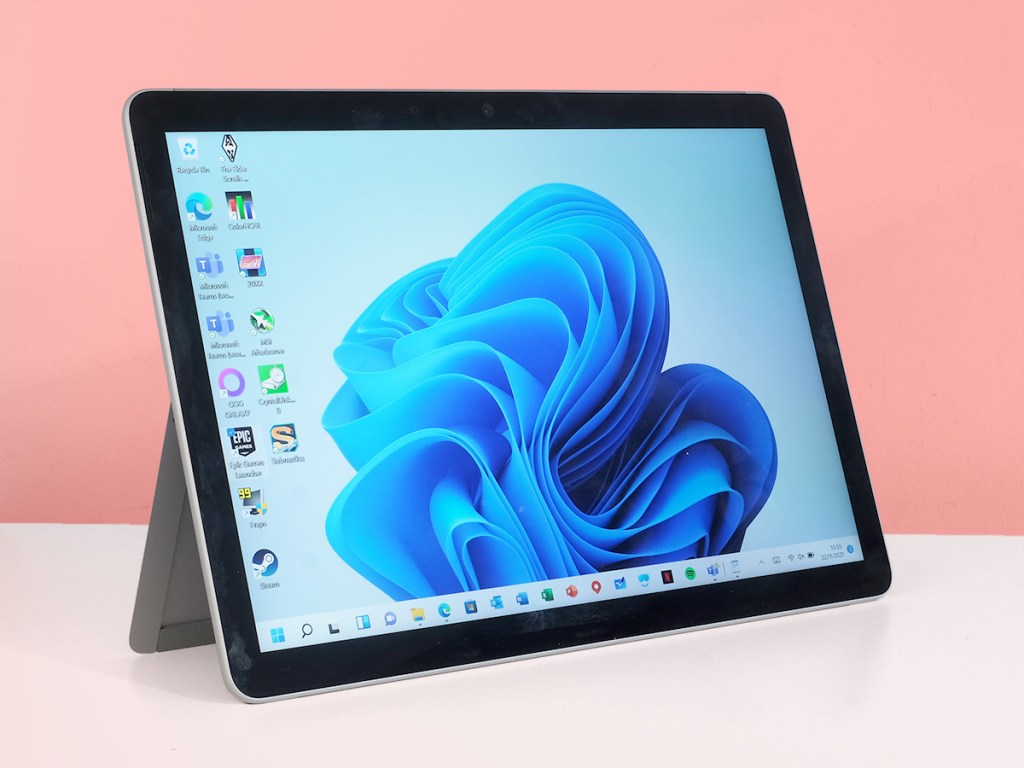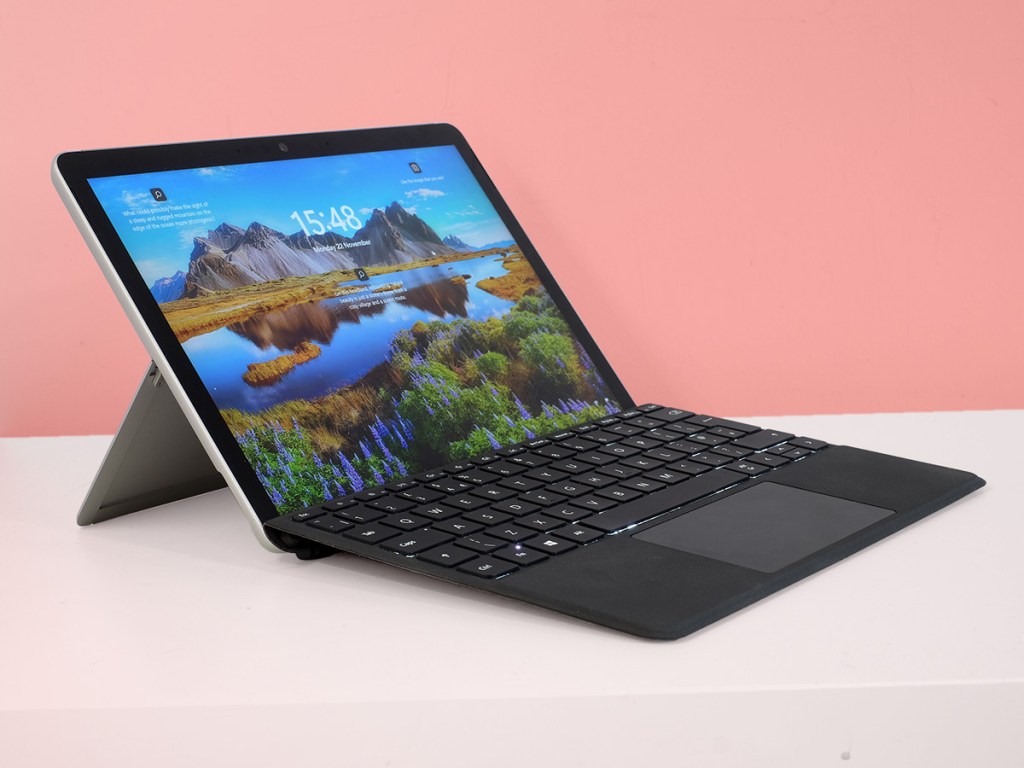Microsoft Surface Go 3 review
Mastering the basics but in need of some serious power

The Microsoft Surface Go 3 is what some wish the iPad was. It’s a reasonably affordable tablet that has the same software as a laptop, Windows 11 in this case.
It can run, or at least try to run, any application you might use on am expensive desktop. But it’s also a slim and light tablet for watching YouTube while in bed or on holiday. The Microsoft Surface Go 3 concept is neat. However, you need to make peace with some real compromises in performance, though.
Microsoft uses new processors in this generation. But even the top-end Surface Go 3 with 8GB RAM and an Intel Core i3 processor seems dramatically underpowered compared to what you can get for similar money. Even the cheapest iPad steamrolls the Surface in some tests.
The Microsoft Surface Go 3 handles the basics just fine. However, if you’re looking for a portable design computer or one for some on-the-go gaming, you’re likely to be disappointed.
That said, there are many more charms to this hybrid. Keep on reading to see if they’ll outweigh the issues for what you need.
The original version of this review was published on 30 November 2021
Design: A bit square



Microsoft hasn’t changed the Go series’ design much this year. It’s still a slim and light slab of magnesium, which is one of the best possible metals for the job.
Glide a finger along the Microsoft Surface Go 3’s back and you’ll notice it has a kind of soft touch finish. It doesn’t have the instant cool feel you usually associate with metal, but feels more expensive than plastic. It’s like polycarbonate and aluminium had a baby.
Microsoft uses magnesium alloy to keep the Microsoft Surface Go 3’s weight down. And that’s important because the Go uses an additional slab of metal for its kickstand. As in previous generations, this thing is great. It’s stiff and study in all the right ways, and lets the display sit at just about any angle from almost upright to almost horizontal.
Of course, it’s not quite as comfy as a classic laptop hinge if you work with the Microsoft Surface Go 3 on your knees, as that thin strip of metal is going to rest somewhere on your legs.
The tablet part weighs 540g according to our scales, around 10% more than a 10.2-inch iPad.
We don’t know why anyone would buy a Microsoft Surface Go 3 for the tablet alone, though. For the full experience you need one of Microsoft’s Type Covers. These hook onto the bottom of the tablet using magnets, and a further series of magnets raises the top of the keyboard up by an inch for a more comfortably typing angle.
As with every hybrid Surface, the Microsoft Surface Go 3 doesn’t include the keyboard. This takes the “real” price of this hybrid to around $700/£700 if you want the keyboard with a fancy Alcantara finish. Alcantara is a kind of man-made suede. We have the standard version, which feels more like a synthetic leather — it feels good too.
How’s the actual typing experience? Surprisingly solid. A standard laptop keyboard is around 20% wider than this one. The small scale of this hybrid demands that the keys are squished together a little. However, the actual key caps are of a normal size.
After 10 minutes we were able to tap away at more-or-less normal speed, with the normal amount of typos. However, we still wouldn’t want to work on a Microsoft Surface Go 3 all day, every day. For that you want something like the Surface Go 2 Laptop.
Hybrids have to make compromises, Microsoft just shrinks them with a high-quality keyboard accessory. Key action feels like that of a proper ultraportable laptop, the keys are backlit and the touchpad is great. It’s a pane of textured glass, not the plastic used in plenty of laptops.
Screen: Shines bright

The Microsoft Surface Go 3 has a 10.5-inch screen of 1920 by 1280 pixels, just like its predecessor. While not as sharp as the 10.2-inch iPad, it is sharper per inch than almost all the “normal” laptops you might buy at around this price.
It’s brighter too, able to reach 400 nits according to our colorimeter test tool. You want this kind of brightness when working outdoors, and it’s the sort of power we see from top-end laptops that sell for $1000/£1000 or more.
Colour is satisfying as well. The Microsoft Surface Go 3 doesn’t have ultra-wide gamut colour like an iPad Pro, but it does reach the silver standard by covering all the tones you need to avoid a weak, unsaturated look. For the screen geeks out there, it fulfils 99% of sRGB, 78% of DCI P3.
For a hybrid that starts at such a low price point, that is not bad at all. You can also get a stylus that offers 4096 pressure sensitivity levels and tilt. But, like the keyboard, this is not included: more ouch.
In the future we’d like to see Microsoft push this design even further by thinning out the screen borders, fitting a larger display into a similar surface area. The Microsoft Surface Go 3 has fairly chunky borders compared to something like the Dell XPS 13. But to ask for a design revolution this year is probably a bit much: let’s not forget the Microsoft Surface Go 3 is an entry-level hybrid.
Performance: Intel’s hollow core

We had hoped to see some more meaningful progress in another area, though: performance. The Microsoft Surface Go 3 gets new processors across the board, but they don’t really bring the kind of boost we were hoping for over the last generation Surface Go 2.
When you configure the Microsoft Surface Go 3 you have a choice of two processors, the Intel Pentium 6500Y and Intel Core i3 10100Y. We’re using the higher-end version, with 8GB RAM and 128GB storage. It’s the best you can get.
Our usual advice for laptop buyers is that if you get an up-to-date Intel Core-series processor, you’re sorted. But this one is a little different because of that sneaky “Y” on the end of the CPU name.
It is only about half as powerful as the 11th Gen Core i3 processors used in normal budget laptops and, judging by the specs, it’s not even that much more powerful than the base Pentium model. You just get a slightly higher clock speed.
The real question here is whether it matters. We wrote this review on the Microsoft Surface Go 3, and did some online research (and mindless browsing) while testing. All that sort of stuff feels pretty good, in part because you still get a fast SSD and RAM.
This Microsoft Surface Go 3 is no good for gaming, though, particularly if you compare it to a normal Core-series CPU laptop with one of Intel’s punchy little Iris Xe graphics chipsets. We tried The Witcher 3 and, well, it didn’t end well. At native resolution, minimum graphics, the frame rate sits in single figures.
Even when you lower the resolution to 1024 x 768, there are regular drops below 10fps, rendering it unplayable.
Scaling things back a bit, we tried Skyrim – the less demanding original release rather than the Special Edition. With a Core i5 ultraportable you can play this game at 1080p, Ultra graphics.
To make it remotely playable on a Surface Go 3 you have to drop down to the lowest graphics setting, which nets you frame rates in the 30s. Drop down to 1280 x 800 pixels and you can get frame rates hovering around 60fps, but with significantly reduced image detail. It’s fun, it’s playable, but probably looks worse than the Nintendo Switch version.
We tried Subnautica on the Microsoft Surface Go 3. It’s a more demanding game than Skryim. It didn’t go too well. While it is just about playable at 1280 x 800 pixel resolution with all the graphics settings cut back, including stripping the water modelling down until it resembles some blocks of jelly being wobbled about in a mixing bowl, we still couldn’t get a solid 30fps.
You need to use ultra-low resolutions to make Subnatica smooth. 320 x 240 pixels, anyone?
The Microsoft Surface Go 3 isn’t a good portable gaming machine. And we wouldn’t use it for anything beyond light Photoshop image editing. More demanding jobs like video editing and digital artwork where you’ll use scads of layers and complicated emulated brushes are best left to laptops with a “proper” Intel Core series processor.
This isn’t a case of Microsoft cheaping out as such.Processors like the Intel Core i3-10100Y are made to consume very little power, and generate very little heat. While many Intel CPUs have made great progress in the last year or so, these battery sippers have not. As you may be able to tell by the name this CPU isn’t even part of the latest generation. It’s a 10th Gen processor, based on a system architecture announced in 2018. Yikes.
It’s why the Microsoft Surface Go 3 could really do with the Windows equivalent of Apple’s M1 processor, something a bit more ambitious. Qualcomm has had a go with its phone-like Snapdragon processors for Windows, but these combine dodgy performance with patchy app support.
The big Intel Core i3 10100Y side effect is it lets the Surface Go 3 run totally silent. There is no fan here to make noise. And even if it does get warm you’re unlikely to notice, as the keyboard part never will.
Battery life: Not bad, not iPad

There’s no room for a gigantic battery in the Microsoft Surface Go 3. It has a 29Wh battery, roughly 10% smaller than the iPad 10.2’s. And it has to run a more involved operating system too, Windows 11.
Using the Surface Go 3 for writing documents and a minimal amount of faffing about on the internet, we found it lasts around eight to eight and a half hours. Streaming video off YouTube gave similar results: you might squeeze out about eight hours 45 minutes if you’re lucky.
However, this is when you’re careful, and don’t leave an energy hog browser with 65 tabs open. We’d find it usable for travelling, although we’re not quite at iPad level here.
Another test showed us exactly how quickly you can drain the Microsoft Surface Go 3, despite it having a processor made to go easy on the juice. A half-hour of Skyrim took exactly 33% off the battery, suggesting battery life can reach as low as 90 minutes — although that sort of stamina is pretty typical for a laptop playing a game that maxes-out its performance.
As with most other Surface hybrids, the Microsoft Surface Go 3’s battery life is passable, not remarkable.
This little laptop does have some other neat features, mind. Its 5-megapixel webcam destroys the competition for image quality. It’s far better than any we’ve tried recently, because almost all of those have tiny little 720p resolution sensors. This is one of the handy side-effects of packing everything into the screen. The depth of the tablet part means there’s room for a pretty good webcam.
There’s also an 8-megapixel rear camera that takes 6-megapixel photos — sure to be appreciated by those who still think that a tablet must have a better camera than their phone just because it has a bigger screen.
The speakers are OK too. While volume and bass aren’t close to an iPad Pro’s, there is enough of a suggestion of bass to make kick drums sound like they exist. And the tone is fairly even, with almost none of the ugly mid-range distortion that can creep in when laptop drivers are maxed-out. We’ll count that as a win.
Microsoft Surface 3 Go verdict

The Microsoft Surface Go 3 is a bit like an iPad dressed up in a business suit. Some long for the days an iPad will be able to run exactly the same desktop-grade apps as their MacBooks, and the Surface series has offered that – but with Windows — for years.
It’s a shame this year doesn’t bring all that much of a performance improvement, which is glaring when all iPads are more powerful and Intel standard laptop processors have become loads faster for graphics in the same window. Even if you buy the top-end Microsoft Surface Go 3, it’s only really suitable for the basics.
But does this matter? The Microsoft Surface Go 3 is an entry-level machine, right? Sure. But when you factor in the keyboard you end up paying a fair chunk. It isn’t pocket change.
If you don’t want to run Photoshop, edit video, play top games released after 2012 or type long essays every day, there’s a lot to like in the Microsoft Surface Go 3. The design hasn’t changed much but it’s still ultra-practical, the webcam flat-out embarrasses those of just about every laptop. And although the keyboard is a little cramped, it’s still comfortable enough for occasional long-form typing.
Stuff Says…
The Surface Go premise makes sense. It’s a tablet that can run any Windows app you like. But it arrives with already dated-looking performance thanks to Intel’s lack of major progress in battery-sipping processors.
Good Stuff
A far better webcam than almost all laptops
High-quality, ultra-portable design
Can run full Windows 11
Bad Stuff
It’s begging for more power
Price gets less appealing when you consider the must-have keyboard
Tech specs
| Dimensions | 24.5cm x 17.5cm x 0.8cm |
| Weight | 533g (544g Wi-Fi) |
| OS | Windows 11 Home in S mode |
| Processor | Intel Pentium Gold 6500Y 10th Gen Intel Core i3-10100Y |
| RAM | 4GB, 8GB |
| Storage | 64GB (128GB SSD) |
| Display | 10.5in, 1920×1280 220 PPI, 3:2 aspect ratio |
| Ports | USB-C, Surface Connect , 3.5mm audio, microSD card reader, Nano SIM (LTE models) |
| Camera | Front-facing 5MP (1080p), Rear-facing 8MP (1080p), IR camera |
| Battery | Up to 11 hours |



